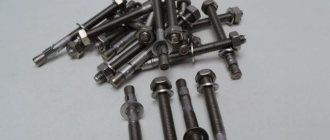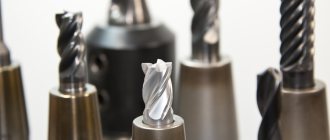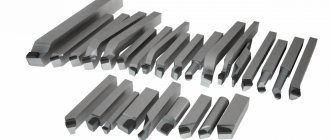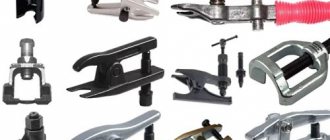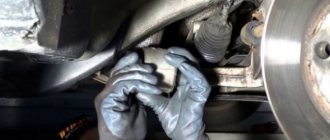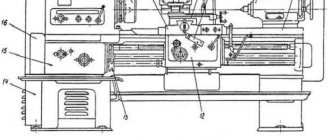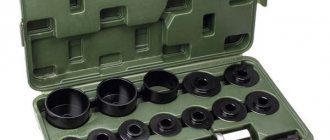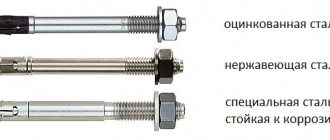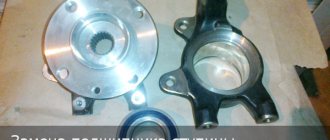Device
The main element in the design of this element is the central bolt. This is what makes the puller work. The bearing is thus squeezed out of the working place or, conversely, pressed in (depending on which direction the central bolt is turned). Some devices are equipped with a hydraulic cylinder (for example, a hydraulic bearing puller, as in the photo below).
The design also includes grips. They come in two varieties:
- Grips that engage with the object being removed using a special tool. They operate independently of the bolt action.
- Pressing the part due to the force of a bolt or hydraulic cylinder.
Wheel hub puller
The second example is how pullers make it easier to repair the chassis of cars. Russia's vehicle fleet, after the decline in sales during the crisis years of 2008–2009, is quite old, despite the revival of sales of commercial vehicles in 2010–2011. When carrying out repair work on the chassis of old and neglected vehicles, repairmen are often faced with the problem of dismantling wheel hubs. Disassembling this unit requires skill, accuracy and is complicated by the significant weight of the parts. This problem is especially acute when it comes to the hubs of truck drive axles. To make the work easier, special devices are used. For example, in the product line of the German company Kukko there is a fairly simple but functional KS-10G puller with a hydraulic drive. Its kit includes: a hydraulic cylinder with a manual drive, developing a force of 10 tons, forged pulling cones with a diameter of 300 and 350 mm and six power, again forged, brackets for attaching the device to the wheel studs.
The puller is assembled and installed on the hub to be dismantled in a matter of minutes. In this case, the hydraulic cylinder is screwed into a pulling cone that is suitable in size to the hub. As practice shows, two cone options (300 and 350 mm) are enough to ensure installation of a puller on the hub of almost any commercial vehicle. To activate the device, it is enough to evenly rotate the screw acting on the piston of the hydraulic cylinder. A smooth increase in force and a uniform, gradual shift of the hub from the axle allow the master to closely control the dismantling process. Well, of course, no hub can withstand the pressure of twenty tons.
Sliding puller
It is quite easy to remove the bearing with this tool. This puller has two grips that move freely along the beam. In the middle of the latter there is a threaded hole. In the upper part, the bolts can serve as clamps for the grips.
This can be a puller for internal or external bearings. To change its purpose, just rearrange the grips. By the way, their maximum solution ranges from 10 to 80 centimeters. The device has stops for the power bolt. This prevents the bearing from moving. The sliding puller set includes jaws of different lengths. The tool is also equipped with replaceable tips. Usually they have the same dimensions (they serve as a replacement in case of failure of the first element).
Bearing pullers
When assembling bearing units, the bearings are installed quite tightly along both the inner and outer rings. Therefore, dismantling bearings requires some effort and care. In small enterprises and at home, they often use homemade soft metal (copper, bronze) drifts and mandrels, but it is correct to use non-impact professional bearing pullers. For example, SKF tools.
Mechanical standard.
These are the simplest and most reliable pullers with two or three jaws. Designed for dismantling bearings with the grips resting on the outer ring. For convenience, they have a self-centering conical tip, and the grips are spring-loaded. In the SKF catalog these are the TMMP and TMMA series.
Reversible.
These are universal pullers that grip the bearing both from the outside and from the inside, while the gripper legs are simply turned 180 degrees. The length of the rods can be adjusted using extensions. In the SKF catalog this is the TMMR series.
Reverse.
These are pullers with collapsible grip shoulders (collapsible clamp), which allows dismantling of bearings in limited space. The length of the rods can be adjusted using extensions. In the SKF catalog this is the TMBS series.
Internal bearing pullers
. Designed for dismantling bearings from blind housings with engagement on the inner race. Features include spring-loaded collet spacer jaws made of high-strength steel and bearing removal using a sliding hammer. SKF TMIC Series (for bearings with a diameter up to 28 mm) and SKF TMIP Series (for bearings with a diameter up to 60 mm, easy spring-loaded positioning).
Needle bearing pullers.
The principle of operation is the same as that of an internal bearing puller. Difference: thinner and shorter claws of collet grippers. Dismantling with a stop or using a sliding hammer.
Pullers for blind holes.
Designed for dismantling open-type radial bearings from blind housings when there is no access to either the outer or inner race. The jaws of the grippers are inserted between the clips with expansion on the outer clip. The jaws are made of high-strength steel and are spring-loaded for easy and secure positioning. Pullers of the SKF TMVR and SKF TMMD series.
Hydraulic.
This can be done by any puller, but already equipped with a hydraulic cylinder and pump. Allows dismantling to be carried out with a few light movements of the lever. Separate hydraulic kits are also produced to equip different types of pullers. Recommended for dismantling forces above 70 kN. The SKF tool range includes hydraulic kits with forces up to 500 kN.
Selecting Bearing Pullers
- First, a series of pullers is selected according to the dismantling conditions. If access to the outer cage is free, then choose the most common mechanical one. When bearings are frequently dismantled from units of different ranges (multi-item small-scale production), more universal reversible pullers are chosen. If it is difficult to access the bearings, choose an internal, blind hole or needle bearing puller.
- In the required series, a puller model with suitable grip sizes (according to the bearing diameter) is selected.
- If the dismantling force is expected to be significant (a particularly tight bearing fit, the need to reuse it), a hydraulic puller is selected.
- If the distance from the end of the shaft to the bearing is large, grip extensions are selected.
The Technobering company is the largest store of bearings and tools for them, the official website of the distributor of the leading manufacturer SKF. All products are certified and comply with Russian GOST and ISO standards.
On the page https://mount.skf.com/?lang=ru you can get free access to information on mounting and dismantling SKF bearings and bearing housings. Here are step-by-step instructions for installation and disassembly.
If you need quality bearing pullers for quick, clean dismantling, purchase them from a company with a long-standing reputation, a wide range of certified products and readily available operational stock.
Experienced, intelligent Technobering specialists will advise, quickly select and recommend the most optimal puller option from several possible ones.
The Technobering store is a reliable supplier of quality tools and accessories for bearing units!
With swivel grips
They have different designs. The grips are locked using bolts. For what vehicles is this bearing puller used? VAZ, MAZ, GAZ, Mercedes - this is an incomplete list of cars on which this tool can be used.
The puller has stops with double-sided grip. There are also three-sided tools. There are 4 mounting points on the body of the device. The paws of the bearing puller are installed on them. The grip width of the device is from 5 to 7 centimeters. Used for removing small bearings, including for removing the tip of battery cables. Can be equipped with a striking mechanism.
Design
The main mechanism of this type of equipment is based on a device consisting of several hook-shaped gripping arms and an additional threaded rod installed between them.
As for the paws, there are usually two or three of them. The main area of application of the universal wheel bearing puller is the capture of a structural sample element. Moreover, it may not only be a vehicle. As a result, with such a device, anyone can independently carry out the mounting or dismantling procedure.
The installation process itself is quite simple. It implies the ability to apply a tightening force, which will allow you to put in place/remove the required element. If the tool is selected taking into account all the nuances, then this can significantly reduce the level of injury.
With separator
These tools are highly reliable. The element is based on a separator. It is installed under the bearing being removed. Both halves of the cage are bolted together for a more secure grip. After this, the pulling part will be connected to the tool.
Its side nuts are adjustable in accordance with the position of the separator. The power bolt is inserted onto the axis of the part being removed. The tool can be used in combination with a sliding puller. However, when working with two mechanisms, it is necessary to ensure the safety of the bolt threads.
Area of application of the tool
Currently, a hydraulic puller is used to dismantle the following parts:
- Bearings;
- Propellers;
- Kingpin;
- Pulleys;
- Bushings;
- coupling;
- Gears;
- Heavy-duty vehicle rims and railway wheels;
- Crankshafts;
- Brake discs.
Pullers are widely used in car service centers and automotive facilities. It is also worth noting that for dismantling kingpins, pullers are widely used in all kinds of repair areas of industrial enterprises. This tool is very often indispensable, and there may be cases when it is even made independently at enterprises. There are times when a factory puller is not at hand, and dismantling is necessary.
Thus, we can say with complete confidence that pullers can be useful in enterprises of all industries and it is advisable to purchase it in advance.
Universal
Universal bearing pullers are most often used. They also remove gears, pulleys and other mechanisms. The design is based on a power bolt made of alloy steel. By rotating it, the master creates a dismantling force that is applied to the support point. Through the central body of the tool, this force is transmitted to the clamps. Thus, the part is pulled out or pressed into place. Universal pullers are used for both internal and external bearings.
Types of universal pullers
There are two types of universal pullers - mechanical and hydraulic. The former are easier to operate, cheaper and more effective. They create a load on the spare part approximately equal to the strength of a person. This tool consists of a central rod on which there is a universal thread, and 2 or 3 legs. Mechanical tools are used for bearings and similar parts.
Hydraulic devices can withstand loads of up to several tens of tons. They have a hydraulic cylinder and do more serious work than power tools. Often used in cases where the spare part is located deep and it is necessary to avoid damage to third-party parts.
Price
The cost may vary depending on the type, as well as the set of tools included in the package.
The cheapest are two- and three-jaw mechanical sliding pullers. Their price ranges from 500 to 1 thousand rubles. Hydraulic devices are the most expensive. They are offered on the market at a price of 25 thousand rubles. The cost of universal mechanical solutions is around 10 thousand rubles. The kit includes a set of mandrels.
Options
To choose the right bearing puller, you need to know what parameters it must meet. When purchasing, you should pay attention to the following points:
- Maximum permissible load. This parameter is determined by the strength of the central body of the puller and the power bolt. For mechanical tools, this parameter ranges from 1 to 4 tons. Hydraulic pullers have a force of about 20 tons (but they also have a corresponding price). However, to dismantle elements such as the wheel bearing, mechanical tools are sufficient.
- Working progress. It depends on the reach of the power bolt and the length of the grips.
- Dimensions of the puller legs (in particular, the width and height of the stop).
- Minimum and maximum gripper opening.
Types and purpose of bearing pullers
First of all, it is worth noting that pullers, in turn, can be of two types - hydraulic and mechanical. Mechanical pullers have a simpler design and structure, but working with them is much more difficult. But hydraulic pullers are quite popular today, they can be purchased at any store that sells similar equipment, and using this tool is very easy and simple. The purpose of both the first and the second puller is exactly the same - they are designed to dismantle, first of all, bearings, as well as pulleys or gears, parts that are installed with a high degree of interference.
DIY primitive puller
You can also make this tool yourself. The main element is a steel pipe. Its diameter should be slightly larger than that of the clip. So, using a grinder, we cut a piece of pipe to the required length. It depends on the size of the screw. Next, using welding, we connect the C-shaped washer to the cut out part of the pipe. On the other side, a nut with internal thread is welded. It must match the parameters of your screw. This type of puller is the easiest to manufacture. However, it will only fit a specific bearing diameter.
Types of pullers by type of grip
There are 4 main types available for different types of gripping and dismantling:
- External puller Designed for external dismantling, when the inner ring of the bearing is installed on the shaft, and the outer ring can be grabbed from the outside.
- Internal puller Designed for internal dismantling, where the outer race of the bearing is installed in the housing and the hole in the inner ring can be grasped from the inside.
- Separator puller Designed for dismantling with gripping the bearing from behind using a tension separator, when its rear part is adjacent to the surface and the external type is not suitable.
- Puller with grip between rings Designed for dismantling bearings that are installed simultaneously on the shaft and in the housing, and all other types are unsuitable.
Making a universal tool
Such a puller will fit different diameters of elements. So, we need to make the legs from a 10mm sheet of steel. It is better to use pre-prepared templates. They can be made on cardboard or paper, then marked on a metal sheet and cut out with a grinder.
Then you need to select a bolt. We sharpen it to a cone. Six ears with holes are welded to the nut. Our paws will be attached to the latter. The ears are cut out of metal 5 millimeters thick. The lugs are welded to the assembled nut. Next, the bolts are unscrewed and the connections of the legs are finally welded. At this stage, the assembly of the device is completed. You can begin to fully use the tool.
